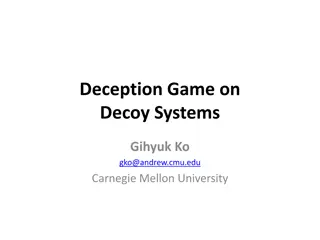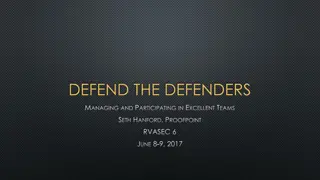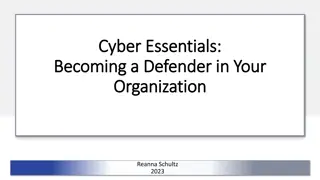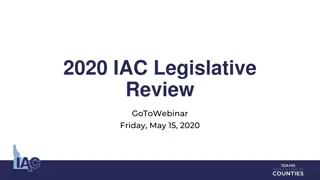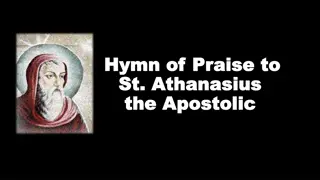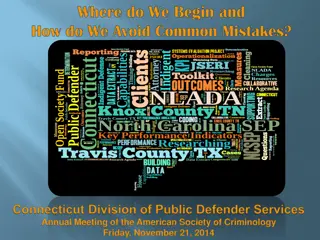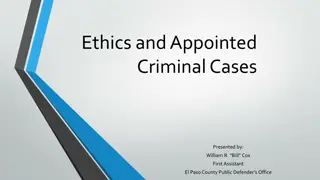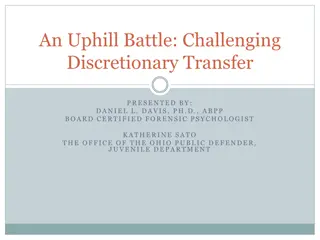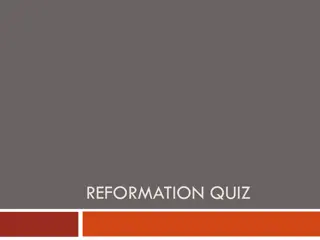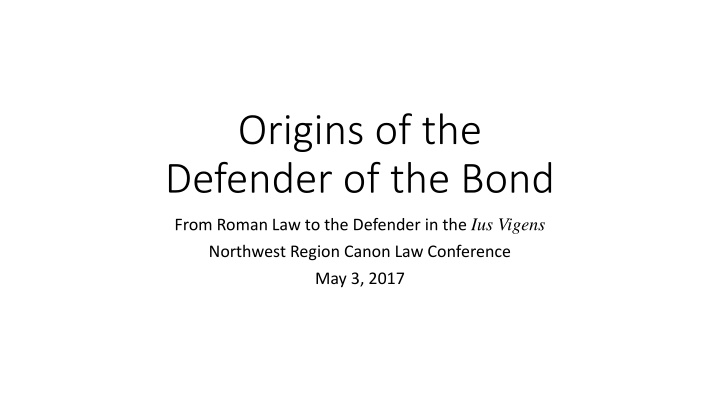
Origins of the Defender of the Bond in Roman Law and Canon Law
Explore the evolution of the Defender of the Bond from Roman Law's accusatorial system to the developments in Canon Law. Discover the historical context, including the principles of self-help, contradictorium, and the shift towards an inquisitorial system. Learn how early Christianity influenced the handling of accusations and the role of accusers and judges.
Uploaded on | 1 Views
Download Presentation

Please find below an Image/Link to download the presentation.
The content on the website is provided AS IS for your information and personal use only. It may not be sold, licensed, or shared on other websites without obtaining consent from the author. If you encounter any issues during the download, it is possible that the publisher has removed the file from their server.
You are allowed to download the files provided on this website for personal or commercial use, subject to the condition that they are used lawfully. All files are the property of their respective owners.
The content on the website is provided AS IS for your information and personal use only. It may not be sold, licensed, or shared on other websites without obtaining consent from the author.
E N D
Presentation Transcript
Origins of the Defender of the Bond From Roman Law to the Defender in the Ius Vigens Northwest Region Canon Law Conference May 3, 2017
Presentation text Available at www.jgray.org Under What s New, select Defender of the Bond.
Roman Law Roman penal law was fundamentally an accusatorial system (via accusationis) built on the principle of self-help. An accuser (actor) had to bring a petition (libellus) to a praetor who would cite the accused (reus) for the contestatio litis and then entrust the doubt to be resolved to a judge (iudex). If the guilt was proven, the accused was bound to pay the penalty (poena). Gratian confirms the necessity of an accuser for an action: Nihil contra quemlibet accusatum absque legitimo et idoneo accusatore fiat . No accusation is brought against anyone unless there is a legitimate and qualified accuser (C. 2 q. 1 c. 4).
Roman Law The contradictorium The fundamental principle of the contradictorium: There are three in judgment. The actor, the reus, and the iudex. To these, Gratian adds the witnesses. In omni iudicio quatuor personas semper esse necesse est, id est iudices electos, et idoneos accusatores, defensores congruos atque legitimos testes . Iudices autem debent uti equitate, testes veritate, accusatores intentione ad amplificandam causam, defensores extenuatione ad minuendam causam. Moreover, the judges must practice equity; the witnesses must tell the truth; the accusers must attend to the development of their case; and the defendants must act to diminish it (C. 4 q. 4 c. 1).
Roman Law The contradictorium Therefore the actor (who favors the action) cannot be the iudex (who must remain impartial). In una enim eademque causa nullus simul potest esse accusator et iudex (C. 2 q. 1 c. 17). In one and the same cause, no one can be simultaneously accuser and judge . This fundamental principle was deeply imbedded in Roman Law.
Roman Law Historical Developments In early Christianity, accusations were too easy to bring and could be used to harass Bishops. Constantinople I (381) instituted the poena talionis , binding the actor to pay the poena if the accusation against the reus was not proven. Consequently, accusations became too difficult to bring, especially against powerful persons. In the 9th Century, the via denuntiationis was introduced, by which criminal conduct to be denounced to an ecclesiastical authority. Still, some crimes went unpunished.
Roman Law The Inquisitorial System Innocent III introduced a reform described in three letters: On September 22, 1198, he entrusted the investigation (inquisitio) of a case of simony to the Archbishop of Milan ex officio, even without an accuser who would come forward (X 3.12.1). On May 5, 1199, he asked the Archbishop of Sens to investigate ex officio the case of a notorious heretic, citing the widespread reputation (fama) of heresy and danger of scandal (X 5.34.10). On December 2, 1199, he wrote to teachers of canon law, pronouncing it licit to initiate a process when the criminal conduct of a cleric reaches the ears of the prelate. It was not that the prelate was both accuser and judge, but rather that demanded by reputation or denounced by outcry, he carries out what is proper to his office (X 5.3.31).
Roman Law The Inquisitorial System In 1215, Innocent III codified the via inquisitionis in Lateran IV. Si per clamorem et famam ad aures superioris pervenerint, non quidem a malevolis et maledicis, sed a providis et honestis non tamquam sit actor et judex, sed quasi deferente fama, vel denunciante clamore, officii sui debitum exequatur . An offense ought to be investigated when news of it comes through clamor or reputation to the ears of the superior, not from spiteful or slanderous persons, but from those who are thoughtful and honest . In this matter, the case should proceed not because the judge is the actor, but rather, as if demanded by reputation or denounced by outcry, he carries out the duty proper to his office .
Roman Law The Inquisitorial System The viainquisitionis depended on a legal fiction: the reputation (fama) takes the place of the actor. Doubt remained because of the appearance that one person served as both accuser and judge. Between 13th and 14th Centuries, as an organic development, causes began to be entrusted to a procurator, or eventually a promoter who came to be known as the promotor fiscalis. The promotor fiscalis acted by office by bringing accusations in the interest of justice and the common good.
Causes of Canonization Procedural development Causes of canonization were original handled by the local Bishop or in a diocesan Synod. Over time, it became preferable to consider these causes in larger gatherings of Bishops, in provincial or regional councils. Various Papal interventions beginning in the 10th Century lead to the definitive reservation of canonizations to the Roman Pontiff in 1234. Once reserved to the Roman Pontiff, causes of canonization came to be treated in a canonical manner. The postulator was the actor causae. Evidence was collected through a canonical process that eventually involved the Roman Rota. The cause was judged by the Pope with the assistance of the cardinals in the Roman Curia.
Causes of Canonization The promoter of the faith In time, a procurator of the faith or a promoter of the faith was heard to clarify doubts about a cause of canonization. By the 16th Century, the promotor fiscalis regularly took part as the promoter of the faith in causes of canonization, acting by office to raise objections against a servant of God in the interest of protecting the faith. A promoter of the faith was regularly nominated in diocesan and apostolic processes. A contradictorium was created between the postulator (advocatus sancti) and the promoter of the faith (advocatus diaboli).
Causes of Canonization The Sacred Congregation of Rites In 1588, Sixtus V created the Sacred Congregation of Rites. From this time forward, the promotor fiscalis regularly served as the promoter of the faith in Causes of Canonization. He had the right to intervene at any stage of the process. He must always be cited for any session of the process. He was always to be heard before rendering a decision about a Cause of Canonization. His duty was to safeguard the faith, to protect divine cult, to see to the observance of the law, to promote justice, to serve the truth.
Causes of Canonization The Sacred Congregation of Rites In 1708, the offices of promotor fiscalis and promoter of the faith were separated. Prospero Lambertini was appointed Coadjutor Promoter of the Faith, and Promoter General in 1712 where he served until 1728. On August 17, 1740, he was elected Pope Benedict XIV.
Causes of Marriage Nullity Little is known of the canonical procedures applied in causes of marriage nullity in the early Church. By the 8th Century, there is evidence of witness testimony was obligatory. By the middle ages, a canonical process had developed involving a contradictorium between three parties: the actor, the parsconventa, and the iudex. There was the presumption that the actor and the parsconventa would take opposing sides, but what if the respondent does not participate, or even shares the petitioner s desire for nullity?
Causes of Marriage Nullity Hostiensis (writing in mid 13th Century) suggested that the court should admit any party that wants to stand for the marriage, such as a family member. By the 14th Century, after the rise of the promotorfiscalis, it became common to ask the promotor to intervene adhoc to defend marriage in certain cases. By the 16th Century, various canonists called for the regular intervention of the promotor, though this was not mandatory.
Causes of Marriage Nullity Reforms of Benedict XIV On April 11, 1741, Benedict XIV wrote to the bishops of Poland in Matriomonii: He lamented that some persons were contracting three or even four ecclesiastical marriages. Judges were either not well trained or even sometimes dishonest. On November 3, 1741, Benedict XIV issued the apostolic constitution Dei Miseratione. He instituted the defender of marriage. He required a mandatory appeal to review affirmative decisions.
Causes of Marriage Nullity Reforms of Benedict XIV Dei Miseratione, 1: We have heard that in some ecclesiastical curias too many judges with imprudent facility, rashness and lack of prudential judgment have issued sentences in favor of the nullity of marriage and have given spouses the ability to marry again with others. These clearly unprepared judges afflicted by the condition of human nature like our first Parent ought to in some way be admonished lest they precipitously and with audacity break the sacred and perpetual bond of marriage.
Causes of Marriage Nullity Reforms of Benedict XIV The defender of marriage, or defender of the bond: Must swear an oath to uphold the bond of marriage; Must be cited for the validity of any juridic act; Had the right to be present for interrogations; Had the right to speak orally or in writing in favor of the marriage; Had the right to adduce anything necessary to sustain the marriage. Was considered to be a true party to the cause, along with the spouses.
Causes of Marriage Nullity Reforms of Benedict XIV The defender reflects Benedict XIV s experience as promoter of faith. The duties of the promoter of the faith safeguard the faith protect divine cult see to the observance of the law promote justice serve the truth The duties of the defender of the bond safeguard the dignity of marriage defend the marriage bond see to the observance of the law promote justice serve the truth
The Promoter and the Defender Today The promotorfiscalis continued as the primary official responsible for bringing accusations of wrongdoing and safeguarding justice up to the beginning of the 20th Century. By the beginning of the 20th Century, he began to be referred to as the promoter of justice, the term used in the 1917 and 1983 Code of Canon Law. The defender of the bond remained fundamentally unchanged from 1741 up to the codification of 1917. Dei Miseratione was the primary font for the canons on the defender in the 1917 Code of Canon Law.
Duties of the Defender of the Bond With special consideration of Mitis Iudex Dominus Iesus August 15, 2015
Mitis Iudex Introduction Through the centuries, the Church, having attained a clearer awareness of the words of Christ, came to and set forth a deeper understanding of the doctrine of the indissolubility of the sacred bond of marriage, developed a system of nullities of matrimonial consent, and put together a judicial process more fitting to the matter so that ecclesiastical discipline might conform more and more to the truth of the faith she was professing.
Mitis Iudex Introduction The Lord Jesus gave to the successors of Peter the power of the keys to carry out the work of truth and justice in the Church. All [the Church s] institutions, constantly subject to improvement, work, each according to its respective duty and mission, toward the goal of transmitting divine grace and constantly promoting the good of the Christian faithful as the Church s essential end.
Mitis Iudex Introduction The zeal for the salvation of souls remains the supreme end of the Church s institutions, rules, and law. The Bishops share in the ecclesial duty of safeguarding the unity of the faith and teaching regarding marriage, the source and center of the Christian family. These reforms respond to the faithful who seek to assuage their consciences, but are often kept back from the juridical structures of the Church because of physical or moral distance. The synod fathers called for a more streamlined and readily accessible judicial process.
Mitis Iudex Introduction These provisions favor not the nullity of marriages, but the speed of processes as well as the simplicity due them, lest the clouds of doubt overshadow the hearts of the faithful awaiting a decision regarding their state because of a delayed sentence. Cases of nullity continue to be handled in a judicial rather than an administrative way, not because the nature of the matter demands it, but rather due to the unparalleled need to safeguard the truth of the sacred bond: something ensured by the judicial order.
Mitis Iudex Status of the Defender of the Bond Many of the provisions of Mitis Iudex streamline and simplify the process for causes of marriage nullity. However, the references to the Defender of the Bond have increased. Canons 1671-1691 1983 Code of Canon Law Canons 1671-1691 Modifications in Mitis Iudex 6 references to the defender of the bond 13 references to the defender of the bond (11 explicit and 2 implicit)
Defender of the Bond Purpose It is for defenders of the bond: to compose and allege observations against the nullity of marriage; to assert evidence in favor of the validity or the consummation of the marriage; and to produce all those things that they think are useful to uphold the marriage (CIC 1917, c. 1968, 3 ). In every grade of trial, the defender is bound by the obligation to propose any kind of proofs, responses and exceptions that, without prejudice to the truth of the matter, contribute to the protection of the bond (Dignitas Connubii, Art 56 3; cfr. CIC 1983, c. 1432). The defender can never act in favor of the nullity of marriage (DC, Art 56 5).
Defender of the Bond A party to the trial The defender of the bond is implicitly a party to the trial under the 1917 Code of Canon Law. The defender of the bond is made an explicit party to the trial in CIC 1983, c. 1433: The defender has the right to be heard when the parties must be heard; The defender has the same right make requests of the court as the parties.
Defender of the Bond Citation If the promoter of justice or defender of the bond was not cited in cases which require their presence, the acts are invalid unless they actually took part even if not cited or, after they have inspected the acts, at least were able to fulfill their function before the sentence (CIC 1983, c. 1433). In causes of the nullity of marriage the presence of the defender of the bond is always required (DC, Art. 56 1). The defender must participate from the beginning of the process and during its course, in accordance with the law (DC, Art. 56 2).
Defender of the Bond Acts of a session A session is a gathering of the members of the tribunal for the purpose of carrying out the work of the trial. The notary is to document everything that takes place during the session, including whether the defender of the bond was present. The citation of the defender of the bond allows him to perform his function at each session.
Defender of the Bond Citation and presence Degree of Participation Actions of the Defender Optimal The defender is cited and participates in every session. Engaged Even if not cited, the defender participates in every session. Periodic The defender does not participate in every session but does respond at specific stages of the cause. Minimal The defender is cited but does not take part until the end when presenting the votum. The defender is not cited and does not take part in the trial. Non-existent (and INVALID)
Defender of the Bond Citation and presence Some authors claim that the failure to cite the defender at the beginning of the trial can lead to irremediable nullity. Failure to cite an obligatory party would essentially negate the process itself. Similarly, the defender may not omit the votum at the end of the trial, since this would constitute a failure to complete the duties that arise from a public office.
The Ordinary Marriage Process It is useful to review the times and the circumstances in which the defender of the bond can and should intervene in the ordinary contentious process of marriage nullity.
The Ordinary Marriage Process Preliminary Phase The defender is to be informed of the appointment of a procurator or advocate (DC, Art. 101 4). The defender is notified when a libellus is accepted (CIC 1983, current c. 1676 1). It is advised that the defender be consulted before rejecting a libellus (DC, Art. 119 2). The defender is heard before the grounds are set by the judicial vicar (CIC 1983, current c. 1676 2). Mitis Iudex does not refer to the possibility of citing the parties to appear for the joinder of the issues, as was previously allowed.
The Ordinary Marriage Process Titles of competence These titles of competence were expanded in Mitis Iudex: the diocese of domicile (or even quasi-domicile) of the petitioner previously consulting the judicial vicar of the respondent. the diocese of the most proofs without previously consulting the judicial vicar of the respondent (CIC 1983, former c. 1673 and current c. 1672). Does the choice of forum burden the respondent or inhibit the respondent s ability to exercise his or her rights? The defender may raise exceptions in the interest of the respondent s right of defense.
The Ordinary Marriage Process Oral Testimony Interrogatories The 1917 code entrusted the defender of the bond with the duty to prepare the interrogatory which was to remain sealed until opened by the judge in the act of examination (CIC 1917, c. 1968, 1 ). The current law allows the defender the right to present items about which the parties are to be questioned (CIC 1983, c. 1533; DC, Art. 164).
The Ordinary Marriage Process Oral Testimony Witnesses The 1917 code gave the defender the right to call his own ex officio witnesses (CIC 1917, cc. 1759 2 and 1969, 3 ). Under the current law, the defender could theoretically call a witness ex officio based on his rights of a party in the trial (CIC 1983, c. 1433). The defender has the explicit right to ask that a witness be heard, even if renounced by one of the parties (DC, Art. 197; cf. C. 1551). The defender also has the explicit right to ask that a witness be recalled for additional testimony (DC, Art. 176; cf. c. 1570).
The Ordinary Marriage Process Oral Testimony Ex Officio questions The defender of the bond has the right to be present during the examination of any witness (CIC 1983, current Can. 1677 1, 1 ; DC Art. 159 1). Even if the judge composes the interrogatory, the defender has the right to suggest questions during the examination. It is for the judge to ask the questions (CIC 1983, c. 1561; DC, Art. 166). Ex officio questions are to be noted in the acts by the notary (CIC 1983, c. 1568; DC, Art. 174).
The Ordinary Marriage Process Experts The defender is to be informed of the appointment of a court expert (DC, Art. 204 2; cf. CIC 1983, c. 1575). Dignitas Connubii provides specific guidance regarding court experts: Questions for the experts are not to exceed their competence. Expert opinions are to be rooted in Christian anthropology and the scientific method (DC, Art. 56 4). The judge must take into account the observations of the defender regarding the individual points about which the assistance of the expert is to be concerned (DC, Art. 207 1; cf. CIC 1983, c. 1577 1).
The Ordinary Marriage Process Publication Publication is directed to the advocates and the parties (CIC 1983, c. 1598 1). This provides the parties with the first opportunity to review the acts in order to request the completion of the proofs. The defender always has access to the acts (CIC 1983, former c. 1678 1, 2 , now current c. 1677 1, 2 ; DC, Art 159 1, 2 ). The defender can always request additional proofs. For the defender, publication constitutes the last opportunity to request additional proofs before the discussion of the cause (DC 236). If the defender has nothing to add, this could serve as the occasion for the judge to decree the conclusion of the cause (DC, Art. 237 2; c. 1599 1).
The Ordinary Marriage Process The votum The right and duty to compose the votum The defender has the right to be heard last, including the right to reply to a second brief from one of the advocates (CIC 1983, c. 1603 3; DC, Art. 243 1). The votumconstitutes one of the defender s most important functions and is generally considered to be a duty that the defender must diligtently fulfill. The defender can make any observations judged opportune in the votum. The defender is not constrained by any predetermined model or formula. The defender is not impartial, but in favor of the bond, and should discharge this duty faithfully.
The Ordinary Marriage Process The votum The approach to the votum The defender protects the law and serves the interests of the truth. Hence the defender need not strenuously emphasize every unfavorable element, cynically presuming the worst possible interpretation. Yet, the defender should not give even slight encouragement in favor of nullity, even in making statements that might appear to be obvious. Severity is prudent. The defender should not ignore a difficulty, even if only slight, lest a declaration of nullity be given for a valid union. In this way, the defender discourages sloppiness and holds the court to a high standard.
The Ordinary Marriage Process The votum The structure of the Votum The acts are composed of procedural acts (acta processus) and those that respond to the question such as the proofs (acta causae). A common approach for defenders of the bond is to first make any procedural observations, and then to address the merits of the cause. A votum that is too brief may fail to adequately defend the bond. A votum that is too long may fail to succinctly clarify the essential objections to the annulment in the mind of the judge.
The Ordinary Marriage Process Full Proof The standard for full proof (in general) Can. 1536 1. The judicial confession of one party relieves the other parties from the burden of proof if it concerns some private matter and the public good is not at stake. 2 In cases which regard the public good, however, a judicial confession and declarations of the parties which are not confessions can have a probative force which the judge must evaluate together with the other circumstances of the case; the force of full proof cannot be attributed to them, however, unless other elements are present which thoroughly corroborate them.
The Ordinary Marriage Process Full Proof The standard for full proof (pre-Mitis Iudex) Can. 1679 (former) Unless there are full proofs from elsewhere, in order to evaluate the depositions of the parties according to the norm of can. 1536, the judge, if possible, is to use witnesses to the credibility of those parties in addition to other indications and supporting factors.
The Ordinary Marriage Process Full Proof The standard for full proof (post-Mitis Iudex) Mitis Iudex appears to have redefined the bias when approaching judicial confessions of the parties. Can. 1678 1 (current) In cases of the nullity of marriage, a judicial confession and the declarations of the parties, possibly supported by witnesses to the credibility of the parties, can have the force of full proof, to be evaluated by the judge after he has considered all the indications and supporting factors, unless other elements are present which weaken them.
The Ordinary Marriage Process Full Proof 1983 Code pre-Mitis Iudex The declarations of the parties cannot have the force of full proof, unless corroborated by other elements. Their probative force must be evaluated with the other circumstances and other indications and supporting factors including credibility witnesses Post-Mitis Iudex The declarations of the parties can have the force of full proof, unless weakened by other elements. Their probative value is to be evaluated after considering all the indications and supporting factors, and can be supported by credibility witnesses.
The Ordinary Marriage Process Appeal Before Mitis Iudex, affirmative sentences were automatically transmitted to the tribunal of second instance which could confirm them by decree or admit to ordinary examination (CIC 1983, former c. 1682). Now the right to appeal belongs to the defender and the parties (CIC 1983, current c. 1680 1). The appellate tribunal can confirm the sentence by decree if the appeal clearly appears merely dilatory (CIC 1983, current c. 1680 2). If the appellate tribunal determines that the appeal is not merely dilatory, then must the cause be examined by a formal process? What if the appellate tribunal wishes to confirm the affirmative decision by decree?
The Ordinary Marriage Process Appeal Can. 1630 1. An appeal must be introduced before the judge who rendered the sentence within the peremptory period of fifteen useful days from the notice of the publication of the sentence. A further question: How many sentences does the defender appeal on an annual basis? What if the answer is zero?
The Ordinary Marriage Process Appeal Reasons to appeal an affirmative decision: The defender is convinced that the invalidity of the marriage has not been proven on even one ground, in spite of an affirmative finding of the judge. The defender is convinced that the judge was in error in finding one or more grounds to be affirmatively proven, while having no objection to the affirmative finding on at least one ground. The defender accepts the decision of the judge in finding the nullity affirmatively proven, but finds the reasoning in the sentence to be inherently flawed or severely deficient.


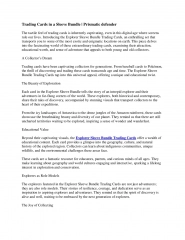
![Guardians of Collection Enhancing Your Trading Card Experience with the Explorer Sleeve Bundle [4-pack]](/thumb/3698/guardians-of-collection-enhancing-your-trading-card-experience-with-the-explorer-sleeve-bundle-4-pack.jpg)


